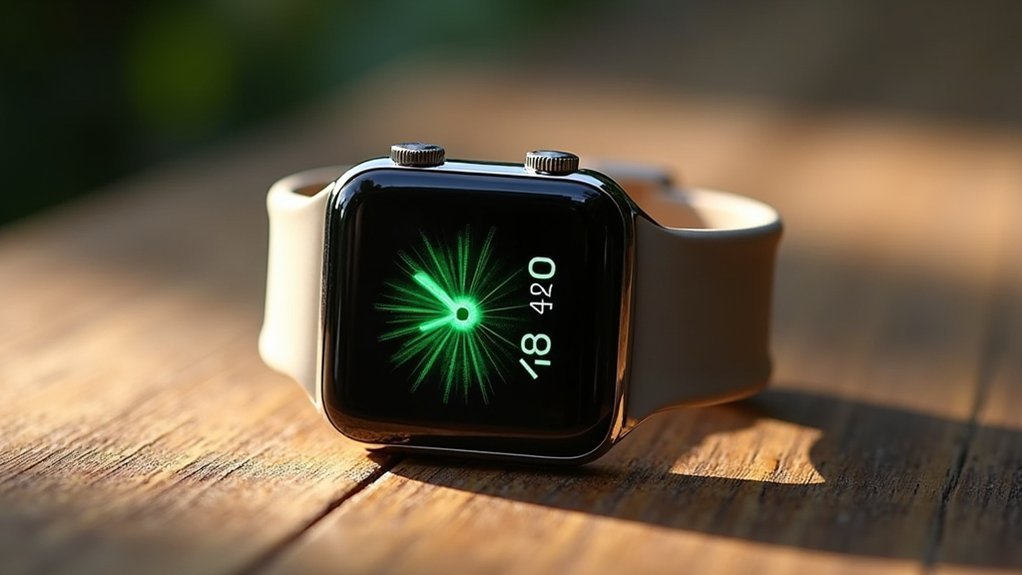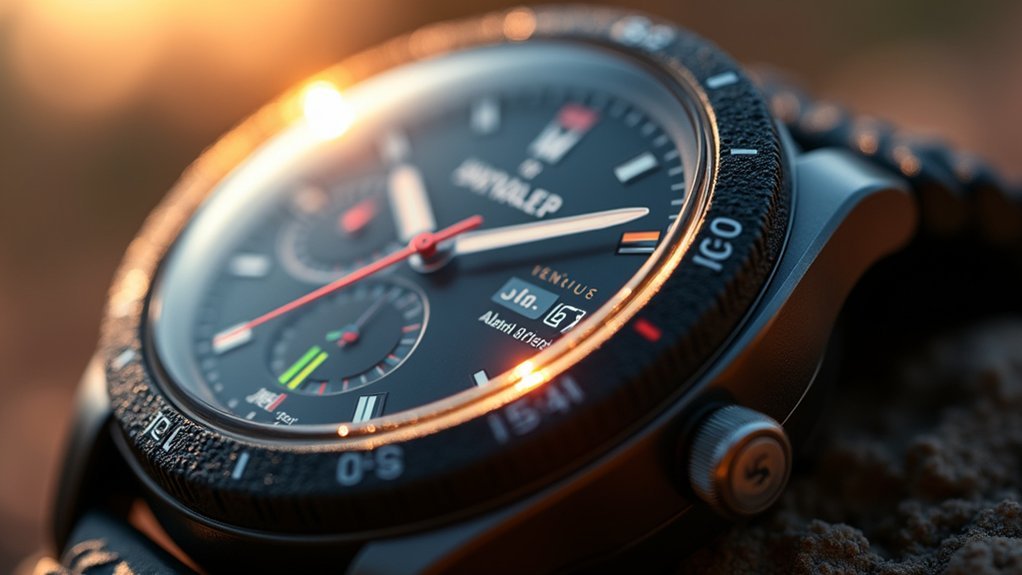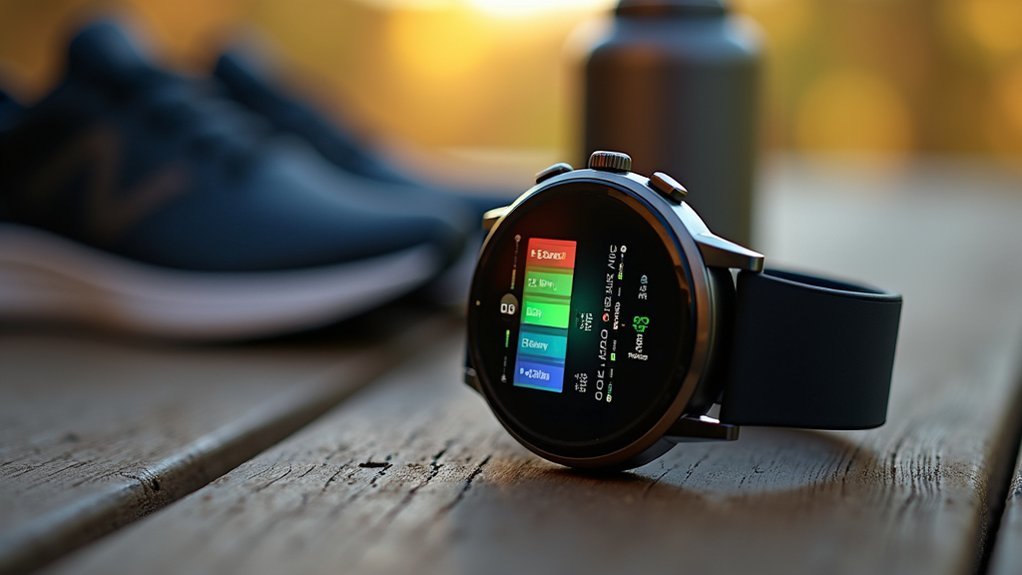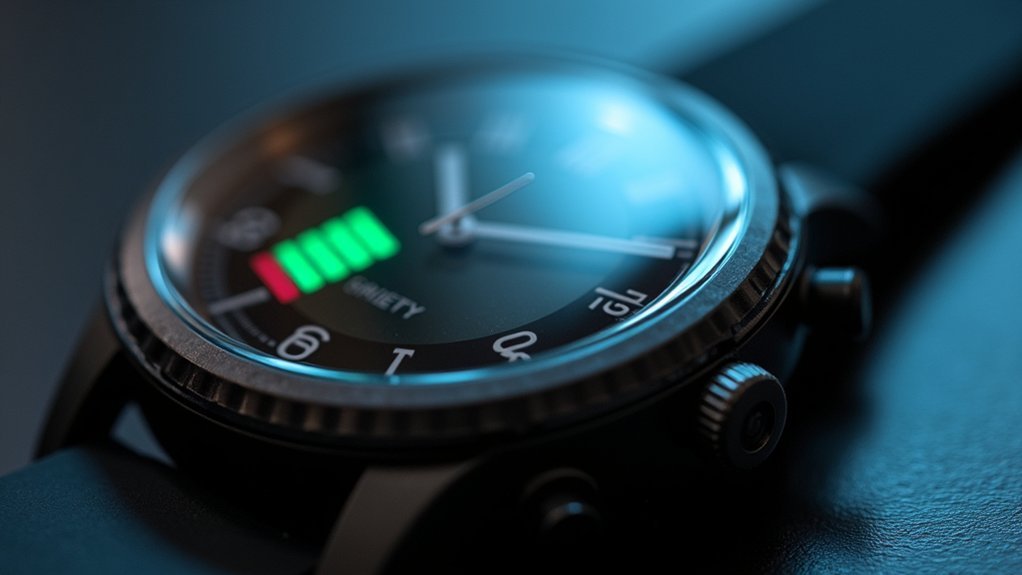Sport watches display battery status through color-coded icons, percentages, and alerts. Red typically indicates low power, while green shows a healthy charge. Most brands offer alerts at specific thresholds—Apple at 10%, Garmin at 5% during activities. You can improve accuracy by performing full discharge-recharge cycles and adjusting settings like GPS frequency and display brightness. Understanding these signals helps you avoid unexpected shutdowns during your most critical training sessions.
Understanding the Battery Icons on Your Sport Watch
Confusion often surrounds those tiny battery symbols on your sport watch, but knowing what they mean can save you from unexpected shutdowns.
When you see a red battery icon on your Apple Watch, it’s signaling low power and needs charging soon.
A red battery icon on your Apple Watch isn’t just a warning – it’s your timepiece urgently requesting a power boost.
Unlike competitors like Coros that use green lightning bolts, Apple Watch displays charging status in nightstand mode without this symbol. You can check your battery percentage by accessing Control Center with a press of the side button.
For extended battery life, consider using Low Power Mode, which reduces power consumption by limiting certain features. A yellow circle icon appears when your watch is in Low Power Mode.
You’ll also benefit from adding battery complications to your watch face for at-a-glance monitoring.
Remember that activating Theater Mode or Silent Mode can help conserve power without disconnecting entirely.
Common Battery Alert Patterns Across Major Brands
While major sport watch manufacturers all incorporate battery alerts, their implementation varies considerably between brands. Most prioritize critical notifications rather than early warnings you might prefer for planning.
| Brand | Alert Threshold | Customizable |
|---|---|---|
| Garmin | 5% during activities | No |
| Apple Watch | 10% standard warning | No |
| Samsung | Unspecified | No |
You’ll notice Garmin devices only alert once at critical levels (5%), with older vivofit models requiring syncing to even see notifications. Many users find these alerts particularly frustrating during windsurfing activities when charging isn’t possible. Apple Watch provides a single 10% alert without tiered warnings, despite user requests for 30%/20%/10% stages. For customizable alerts across any brand, third-party solutions like Battery Alert app can fill these gaps, though they require installation on both your watch and phone.
How to Interpret Percentage vs. Visual Battery Indicators

When your sport watch displays battery information, understanding the difference between percentage indicators and visual symbols can greatly impact how you manage your device’s power.
Percentage readings offer precise data—you’ll know exactly where you stand at 42% versus a vague “half-full” visual bar.
Visual indicators like color-coded icons or graphical bars provide quick glances at battery status without requiring you to process numbers. Green typically means charged, while red signals low power.
Some analog watches use mechanical indicators, such as altered second-hand movements, to signal low energy.
Many watches now offer hybrid displays combining both methods. You can customize your watch face to show percentages alone or alongside visual indicators, giving you both precision and at-a-glance readability during your activities. For immediate battery information, simply press and hold the MENU button to view your current charge state.
Maximizing Accuracy of Battery Life Readings
To get the most reliable battery readings from your sport watch, you’ll need to understand how various features affect power consumption and reporting.
Start by optimizing GPS frequency—choose 5-second intervals for balanced tracking or 60-second for steady activities like hiking.
Manage display settings by reducing brightness and disabling auto-backlight features when unnecessary.
Remove or limit third-party apps that run background processes, especially those with constant heart rate monitoring.
Be aware of environmental factors—cold temperatures temporarily reduce battery performance but don’t indicate actual capacity issues.
For the most accurate readings, occasionally perform a full discharge-recharge cycle to recalibrate the battery monitoring system.
Newer watches with smart discharge algorithms provide more precise estimates based on your specific usage patterns and sensor activation.
On longer adventures like ultra marathons, consider carrying portable chargers to extend recording time without compromising data collection.
When Battery Indicators Mislead: Calibration Techniques

Despite their sophisticated technology, sport watch battery indicators can sometimes display misleading information that doesn’t reflect actual power levels. Common triggers include rapid percentage jumps, extended storage periods, or battery replacements.
To recalibrate your COROS watch, charge it 30-60 minutes beyond 100%, then drain until shutdown, and recharge uninterrupted. Finish with a soft reset. For persistent issues, consider a factory reset.
Garmin watches handle battery information differently, focusing on display format adjustments rather than direct recalibration. You can toggle between estimated days remaining and percentage views.
Technically, calibration works by synchronizing discharge/charge flags and resetting coulomb counters.
Verify success by checking charge duration, discharge patterns, and idle drain rates post-calibration. If your watch continues to show battery issues after calibration, you should sync your device to the COROS app before attempting any further troubleshooting steps.
Battery Status During High-Intensity Activities
While calibration corrects misleading battery readings, knowing how your sport watch handles power demands during intense workouts presents an entirely different challenge.
During high-intensity activities, your watch’s battery drains faster due to increased heart rate monitoring, frequent GPS usage, and more screen activations.
When you’re pushing your limits, your watch is working harder too—vibration alerts, navigation features, and backlight activation all accelerate battery consumption.
Consider switching to custom battery modes specifically configured for your workout type, balancing necessary tracking with power conservation.
For endurance events, manufacturer claims rarely match real-world performance.
You’ll need to disable non-essential features like notifications and reduce sensor sampling rates. Checking the Battery Usage Tool in your Toolbox can provide valuable insights about which features are consuming the most power.
Pay attention to those 20% and 10% warnings, as they’re your cue to adjust settings mid-activity to finish your workout with power to spare.
Solar Charging Indicators and What They Really Mean

Solar charging indicators on sport watches represent more than simple battery status—they’re sophisticated monitoring systems designed to communicate complex power relationships.
These signals vary across brands but share common patterns. When you see flashing icons, your watch is typically warning you about low charge. Steady illumination indicates active charging, while animated battery bars show real-time progress. Color-coded alerts differentiate between critical and normal conditions. Some models, like those with Tough Solar system, can power all watch functions through light exposure alone without requiring battery replacement.
Solar watch indicators follow universal logic—flashing means low power, steady shows charging, animation displays progress, and colors indicate severity.
Don’t be fooled by false readings. Your watch may display “full” prematurely if exposed to inconsistent light conditions. Temperature also affects accuracy—cold weather can make your battery appear more depleted than it actually is.
For ideal charging, place your watch in direct sunlight rather than relying on indoor lighting, which charges at substantially slower rates.
The Science Behind Battery Health Monitoring
Beneath the sleek surfaces of today’s sport watches lies an intricate system of technological marvels that constantly evaluate your battery’s condition. Your device employs embedded sensors to track voltage stability, temperature fluctuations, and charge cycles—all vital indicators of battery health. Recent advances in battery technology have significantly enhanced both sensor accuracy and power efficiency in modern wearable devices.
| Monitoring Parameter | What It Tracks | Why It Matters |
|---|---|---|
| Voltage Analysis | Power output consistency | Identifies early failure signs |
| Thermal Monitoring | Battery temperature | Prevents heat-related degradation |
| Cycle Counting | Number of charges | Predicts remaining lifespan |
| Load Response | Performance under stress | Guarantees reliability during workouts |
These systems work alongside power optimization algorithms that balance functionality with battery preservation. When your watch displays that battery percentage, it’s actually interpreting complex data from these monitoring systems—not simply counting down from 100%. This sophistication allows your device to provide reliable performance even in challenging environments.
Customizing Battery Alerts for Your Training Needs

When designing your training experience, personalizing battery alerts can make the difference between completing your workout and facing an unexpected shutdown.
Navigate to MENU → Power Manager → Battery Saver → Low Battery Alert to access customization options directly on your watch.
Optimize your watch’s power settings in seconds through the intuitive Battery Saver menu for uninterrupted performance when it matters most.
Create sport-specific profiles with tailored battery thresholds that match your activity demands. Each optimization choice displays the estimated battery life you’ll gain by disabling specific features.
- Set custom low-battery percentage thresholds for different sports
- Disable pulse oximeter monitoring for substantial battery gains
- Toggle wrist-based heart rate tracking during less intensive activities
- Create saved configurations for repeating workout types
- Switch to the ultra-low-power watch face for critical battery situations
For extended adventures, consider the Tour mode which maximizes battery by limiting power-hungry sensors while maintaining essential tracking. You can hold the MENU button to quickly access the controls menu for battery saver options during activities.
Comparing Battery Display Technologies Across Watches
Although both technologies have their merits, AMOLED and MIP displays represent fundamentally different approaches to battery management in sport watches.
When you’re choosing between them, consider your primary activities and usage patterns.
AMOLED screens deliver striking visuals with higher resolution (454×454 pixels) and vibrant colors, making detailed maps and data screens pop.
However, they drain batteries faster because they actively emit light.
In contrast, MIP displays excel in outdoor visibility and power efficiency.
With lower resolution (typically 260×260), they use ambient light to remain visible in sunshine, requiring power only for display changes.
Many Garmin Fenix models combine MIP with solar charging for exceptional battery longevity.
Recent models show that battery life depends more on overall watch technology than just the display type, with some AMOLED watches matching or exceeding their MIP counterparts in longevity.
Your choice depends on whether you prioritize visual experience or extended battery life between charges.
Power-Saving Modes and Their Impact on Status Readings
Power-saving modes fundamentally change how your sport watch operates while displaying distinctive signals about its battery status. When activated, your watch will show special indicators—Apple uses yellow, while others display unique icons to signal conservation mode is active.
These modes typically kick in automatically at low percentages or can be manually activated through settings.
While in power-saving mode, you’ll notice:
- Screen brightness dims considerably to reduce power consumption
- Always-on display features typically disable completely
- Background data syncing pauses or becomes less frequent
- Notifications may arrive with delays due to intermittent connectivity
- Battery percentage indicators often display more prominently
Understanding these signals helps you manage battery life more effectively. Power saving mode also disables important health tracking features such as workout auto-detection and background heart rate monitoring.
Most watches automatically exit power-saving mode once charged to 80% unless you’ve set custom preferences.
Troubleshooting Inaccurate Battery Level Displays
Even with power-saving modes working correctly, you may encounter frustrating discrepancies between your sport watch’s displayed battery level and its actual charge.
These inaccuracies often stem from calibration issues caused by frequent partial charging cycles.
To resolve this, try fully charging your watch to 100% then completely draining it. This recalibrates the battery sensors and improves reading accuracy.
Battery calibration requires a full charge-discharge cycle to reset sensors and restore accurate readings.
If problems persist, restart your device or perform a hard reset.
Environmental factors like extreme temperatures and intensive sensor use can also affect readings.
Check if your companion app needs updating or if its cache requires clearing, as synchronization issues commonly cause stale battery reports.
For older watches, erratic battery behavior may indicate battery degradation.
In these cases, professional servicing might be your best solution.
Consider installing the Battery GUESSTIMATE widget which provides more accurate estimates based on your actual usage patterns rather than relying on default predictions.
Frequently Asked Questions
Can Third-Party Watch Bands Affect Battery Consumption?
Yes, third-party watch bands can affect your battery consumption by blocking charging ports, interfering with sensors, triggering false off-wrist detection, or adding battery packs that might cause heating issues despite extending battery life.
How Does Swimming in Saltwater Impact Battery Indicator Accuracy?
Saltwater can cause your watch to display inaccurate battery levels. Salt residue creates corrosion on battery terminals, increasing resistance and triggering false low-battery alerts even when you’ve got sufficient charge remaining.
Will Factory Resetting My Watch Improve Battery Health?
No, factory resetting won’t improve your watch’s actual battery health. It only clears software issues that might cause battery drain. Physical battery degradation from age and charge cycles can’t be reversed through resets.
Do Extreme Temperatures Permanently Damage Battery Status Sensors?
Extreme temperatures rarely damage your watch’s battery sensors permanently. While heat can accelerate battery wear and cold may cause temporary inaccurate readings, the sensors themselves are designed to withstand reasonable temperature variations without permanent harm.
Can Watch Face Brightness Settings Cause False Battery Readings?
Brightness settings don’t cause false readings, but they directly impact battery consumption. Your watch isn’t reporting incorrectly—it’s accurately showing faster drain when you’re using higher brightness, which consumes more power.
In Summary
You’ve now got the skills to decode your sport watch’s battery signals accurately. Don’t let misleading indicators disrupt your training again. By understanding alert patterns, calibrating regularly, and customizing notifications, you’ll stay ahead of power issues. Remember to leverage power-saving modes when needed, but know how they affect readings. With these insights, you’re equipped to manage battery life effectively during all your athletic pursuits.





Leave a Reply